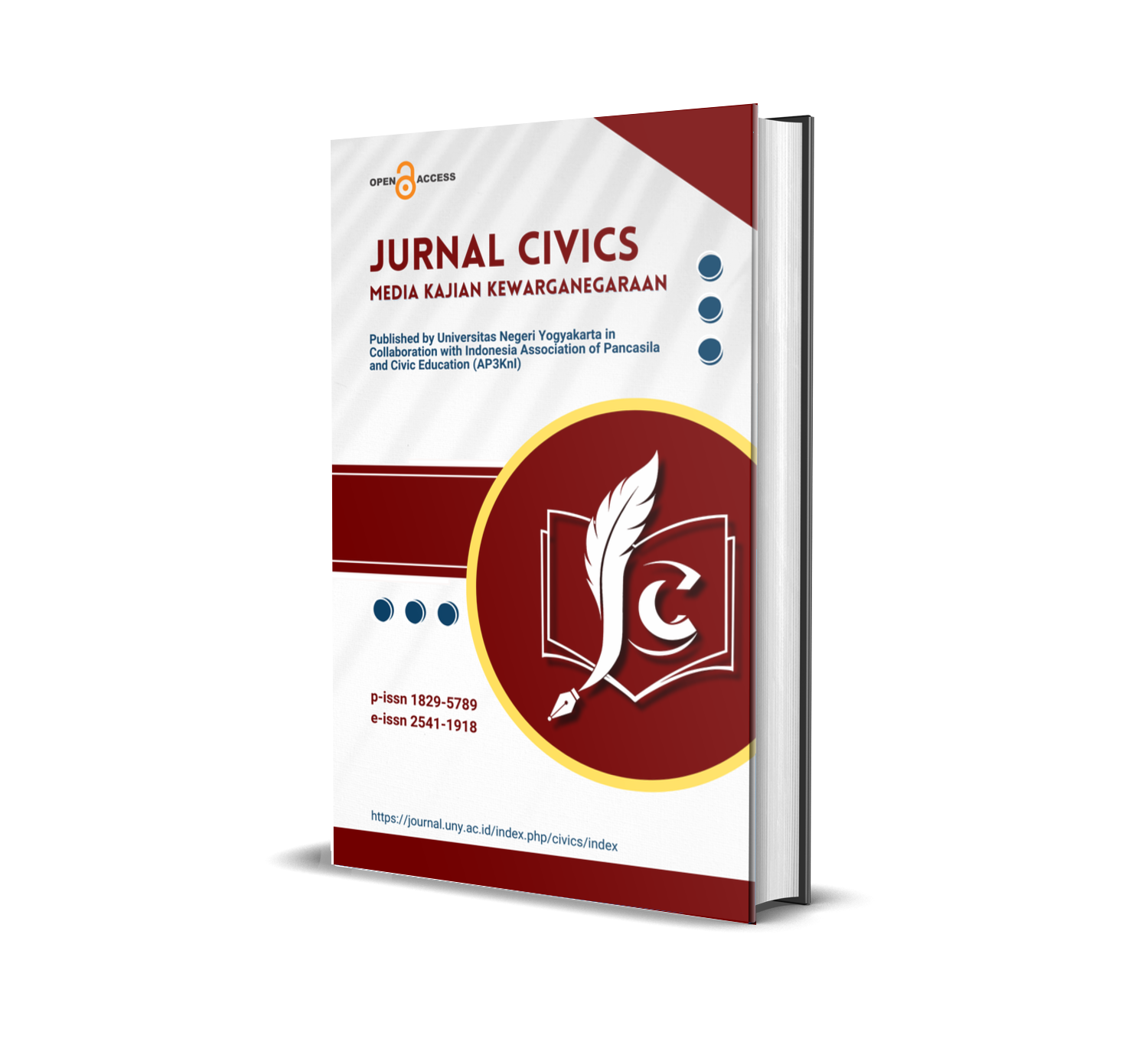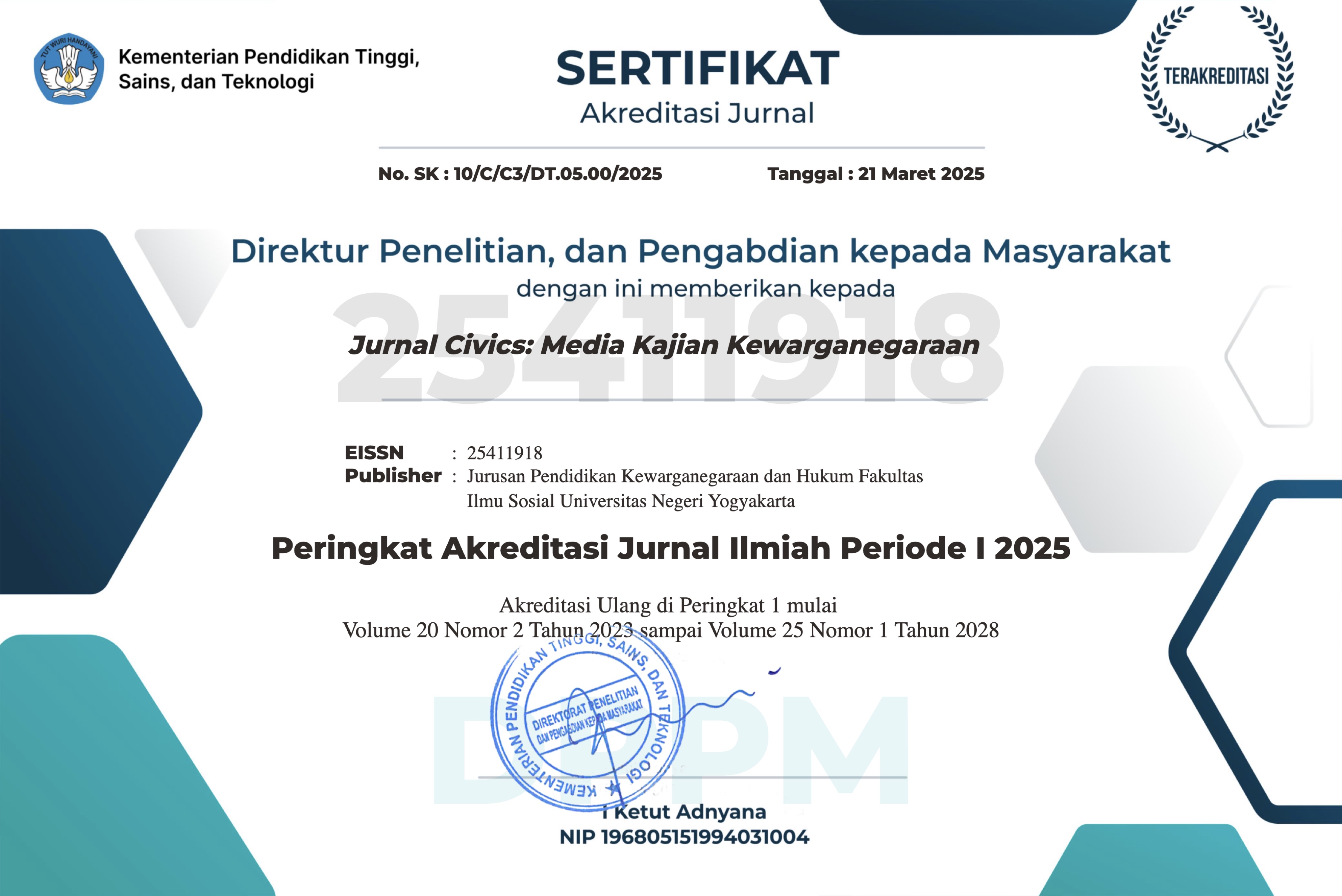The efforts of Melayu Berbudaya community in promoting mechanical solidarity among its members
DOI:
https://doi.org/10.21831/jc.v20i1.53429Keywords:
mechanical solidarity, melayu, west KalimantanAbstract
The purpose of this study is to describe the efforts of Melayu Berbudaya Community in promoting mechanical solidarity among its members in South Pontianak District. The approach to this research is descriptive qualitative research. The results of the study showed that there are efforts among the members of Melayu Berbudaya Community in promoting mechanical solidarity in the low division of labor, strong collective awareness and low individuality among members. These things were promoted well because the members tried to maximize it in various ways. They were taking time to gather inside and outside their activities, contributing to each other, understanding each other and considering each other as family members. In addition, the goals of the members can be done because there are same purposes among them. Members of Melayu Berbudaya Community have strong mechanical solidarity, in which each member always creates togetherness and familiarity among members and works together to help people who need the help of Melayu Berbudaya Community.
References
Alfarabi, A., Venus, A., Syafirah, N. A., & Salam, N. E. (2019). Media identitas Melayu pascareformasi di Indonesia. International Journal of Multicultural and Multireligious Understanding, 6(7), 21–31.
Alhafizah, A., Bahari, Y., & Fatmawati, F. (2019). Analisis solidaritas mekanik pada organisasi bapakat etnis Dayak Kanayatn Desa Pancaroba Kecamatan Sungai Ambawang. Jurnal Pendidikan Dan Pembelajaran Khatulistiwa (JPPK), 8(3), 1–8.
Ashraf, N., & Bandiera, O. (2018). Social incentives in organizations. Annual Review of Economics, 10(1), 439–463. https://doi.org/10.1146/annurev-economics-063016-104324
Cobigo, V., Martin, L., & Mcheimech, R. (2016). Understanding community. Canadian Journal of Disability Studies, 5(4), 181–203. https://doi.org/10.15353/cjds.v5i4.318
Creswell, J. W. (2014). Research design: Qualitative, quantitative, and mixed methods approaches. SAGE Publications.
DeMarrais, E., & Earle, T. (2017). Collective action theory and the dynamics of complex societies. Annual Review of Anthropology, 46(1), 183–201. https://doi.org/10.1146/annurev-anthro-102116-041409
Desti, D., Syafrizal, S., & Resdati, R. (2022). Interaksi sosial pekerja perempuan di usaha pengolahan kopra (studi kasus pada usaha pengolahan kopra di Parit No. 02 Mulya Desa Kayu Raja. Jurnal Pendidikan Sosiologi Dan Humaniora, 13(1), 141–148. https://doi.org/10.26418/j-psh.v13i1.52797
Erikson, E., & Shirado, H. (2021). Networks, property, and the division of labor. American Sociological Review, 86(4), 759–786. https://doi.org/10.1177/00031224211027893
Hidayah, R. A., & Ramadhan, I. (2021). Sistem sosial budaya Indonesia. Penerbit Lakeisha.
Iqlima, D., & Wijaya, A. (2022). Modal Sosial petani nanas dalam jaringan distribusi nanas madu Pemalang. Jurnal Pendidikan Sosiologi Dan Humaniora, 13(2), 421. https://doi.org/10.26418/j-psh.v13i2.56258
Jumiliani, J., Fatmawati, F., & Ramadhan, I. (2021). Analisis solidaritas sosial mekanik pada etnis Madura dan Melayu di Kelurahan Siantan Tengah Kecamatan Pontianak Utara. Jurnal Pendidikan Dan Pembelajaran Khatulistiwa (JPPK)2021, 10(3), 1–8.
Kurnia, N., & Bahari, Y. (2014). Ikatan solidaritas sosial berdasarkan latar belakang pendidikan pekerja di PT Sari Bumi Kusuma. Jurnal Pendidikan Dan Pembelajaran Khatulistiwa (JPPK), 3(7). https://jurnal.untan.ac.id/index.php/jpdpb/article/view/6298/6461
Li, J. (2020). Humans as social beings-From ‘People first’ to ‘People-centered’. Scientific and Social Research, 2(2), 43–46.
Maliki, Z. (2012). Rekonstruksi teori sosial modern. Gadjah Mada University Press.
Maliki, Z. (2018). Rekontruksi teori sosial modern. UGM PRESS.
Mawarpury, M. (2018). Analisis Koping dan Pertumbuhan Pasca-trauma pada Masyarakat Terpapar Konflik. Psikohumaniora: Jurnal Penelitian Psikologi, 3(2), 211–222. https://doi.org/10.21580/pjpp.v3i2.2818
Moll, H., Pueschel, E., Ni, Q., & Little, A. (2021). Sharing experiences in infancy: From primary intersubjectivity to shared intentionality. Frontiers in Psychology, 12. https://doi.org/10.3389/fpsyg.2021.667679
Mueller, A. S., & Abrutyn, S. (2016). Adolescents under pressure: A new durkheimian framework for understanding adolescent suicide in a cohesive community. American Sociological Review, 81(5), 877–899. https://doi.org/10.1177/0003122416663464
Polletta, F., & Jasper, J. M. (2001). Collective identity and social movements. Annual Review of Sociology, 27(1), 283–305. https://doi.org/10.1146/annurev.soc.27.1.283
Prasojo, Z. H., Elmansyah, E., & Haji Masri, M. S. (2019). Moderate Islam and the social construction of multi-ethnic communities in the hinterland of west Kalimantan. Indonesian Journal of Islam and Muslim Societies, 9(2), 217–239. https://doi.org/10.18326/ijims.v9i2.217-240
Ramadhan, I., Dewantara, J. A., Efriani, E., Olendo, Y. O., & Bafadal, M. F. (2020). Waterfront sebagai modal sosial ekonomi masyarakat di tepian sungai Kapuas. ETNOREFLIKA: Jurnal Sosial Dan Budaya, 9(3), 213–225. https://doi.org/10.33772/etnoreflika.v9i3.877
Rino, R., Imran, I., Ramadhan, I., & Dewantara, jagad A. (2022). Analisis rasionalisasi nilai-nilai mitos tradisi bepapas pada masyarakat Melayu Sambas di Desa Tempapan Hulu Kabupaten Sambas. Jurnal Kewarganegaraan, 6(2), 3051–3065.
Ruswinarsih, S. (2020). Solidaritas sosial kelompok waria Paris Barantai di Banjarmasin. PADARINGAN (Jurnal Pendidikan Sosiologi Antropologi), 2(3), 303. https://doi.org/10.20527/padaringan.v2i3.2438
Sanders, J. M. (2002). Ethnic boundaries and Identity in plural societies. Annual Review of Sociology, 28(1), 327–357. https://doi.org/10.1146/annurev.soc.28.110601.140741
Schwartz, S. (2008). The 7 Schwartz cultural value orientation scores for 80 countries. https://doi.org/10.13140/RG.2.1.3313.3040
Shayo, M. (2020). Social identity and economic policy. Annual Review of Economics, 12(1), 355–389. https://doi.org/10.1146/annurev-economics-082019-110313
Trajkovski, G., & Collins, S. G. (2009). Handbook of research on agent-based societies: Social and cultural interactions. Information Science Reference.
Wiyono, H., & Ramadhan, I. (2021). Pergeseran tradisi belalek dalam budaya bertani masyarakat Melayu Sambas. Jurnal Studi Agama Dan Masyarakat, 17(1), 1–9. https://doi.org/10.23971/jsam.v17i1.2880
Yani, F. N. (2021). Partisipasi relawan komunitas Yogyakarta mengajar wilayah bener dalam meningkatkan keterampilan kecakapan hidup anak. Jurnal Pendidikan Sosiologi Dan Humaniora, 12(2), 71–76. https://doi.org/10.26418/j-psh.v12i2.47678
Zaluchu, S. E. (2020). Strategi penelitian kualitatif dan kuantitatif di dalam penelitian agama. Evangelikal: Jurnal Teologi Injili Dan Pembinaan Warga Jemaat, 4(1), 28–38. https://doi.org/10.46445/ejti.v4i1.167
Downloads
Published
How to Cite
Issue
Section
Citation Check
License
The authors agree to transfer the transfer copyright of the article to The Jurnal Civics: Media Kajian Kewarganegaraan effective if and when the paper is accepted for publication.
Authors and other parties are bound to the Creative Commons Attribution-NonCommercial-ShareAlike 4.0 International License for the published articles, legal formal aspect of journal publication accessibility refers to Creative Commons Attribution-NonCommercial-ShareAlike 4.0 International License (CC BY-NC-SA).










